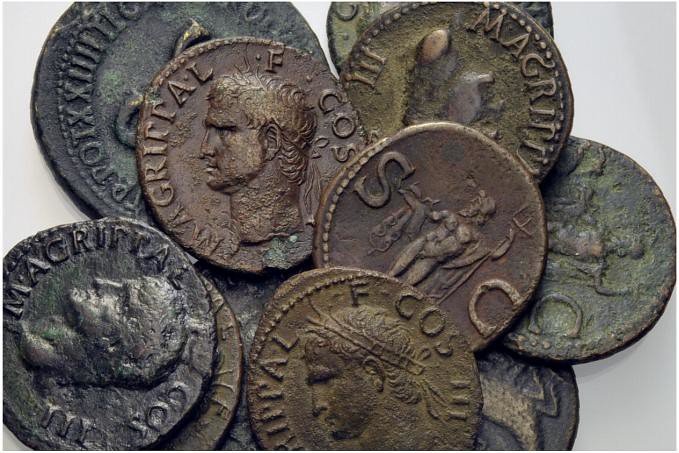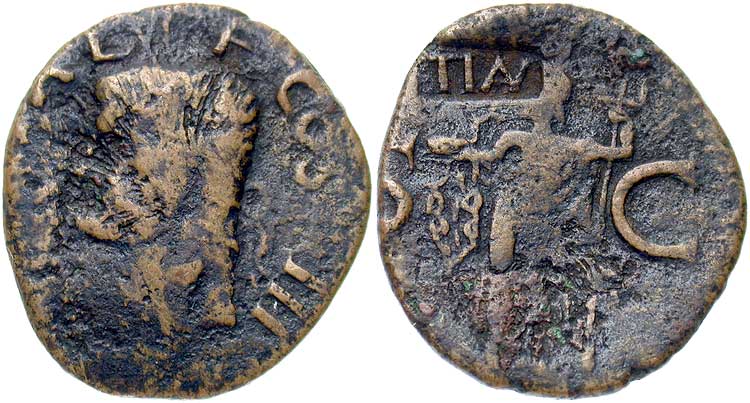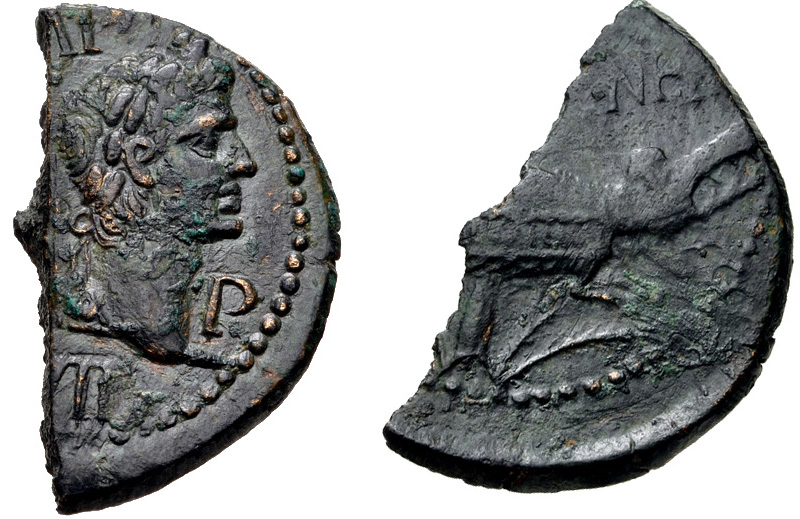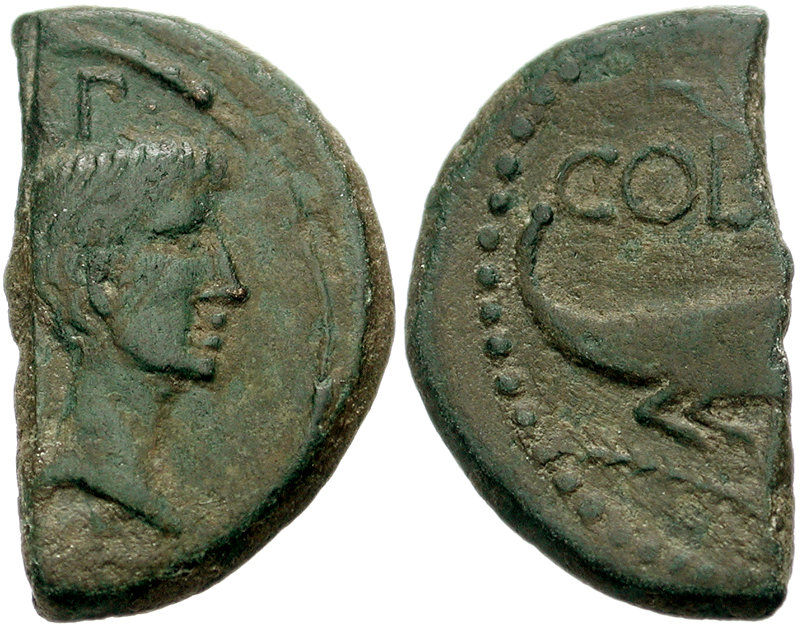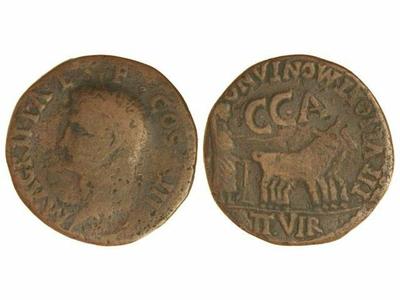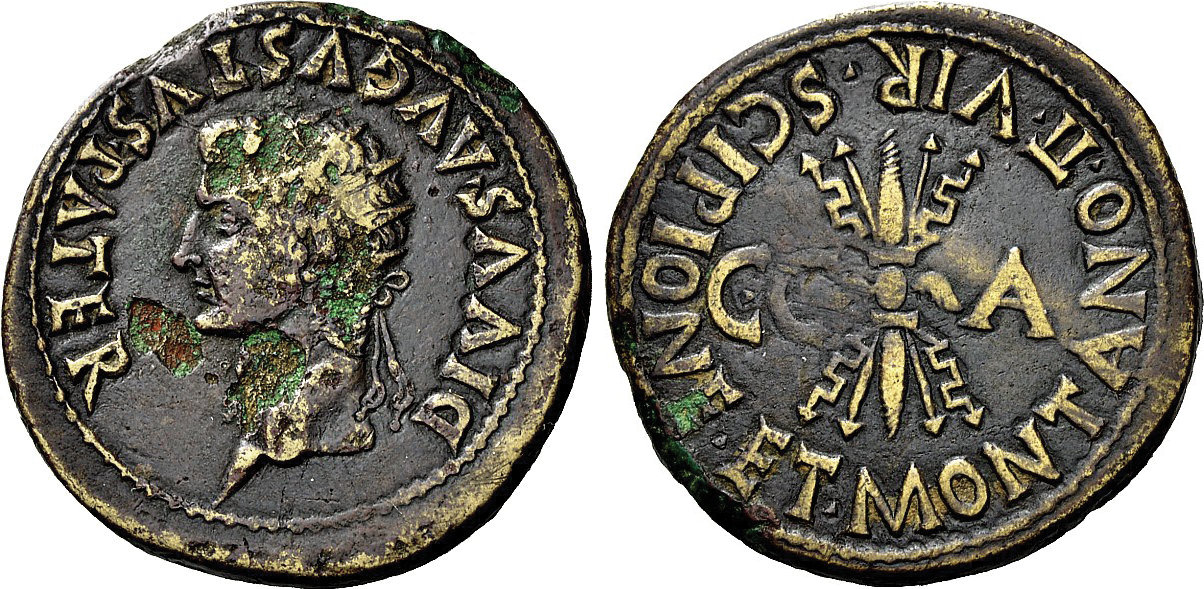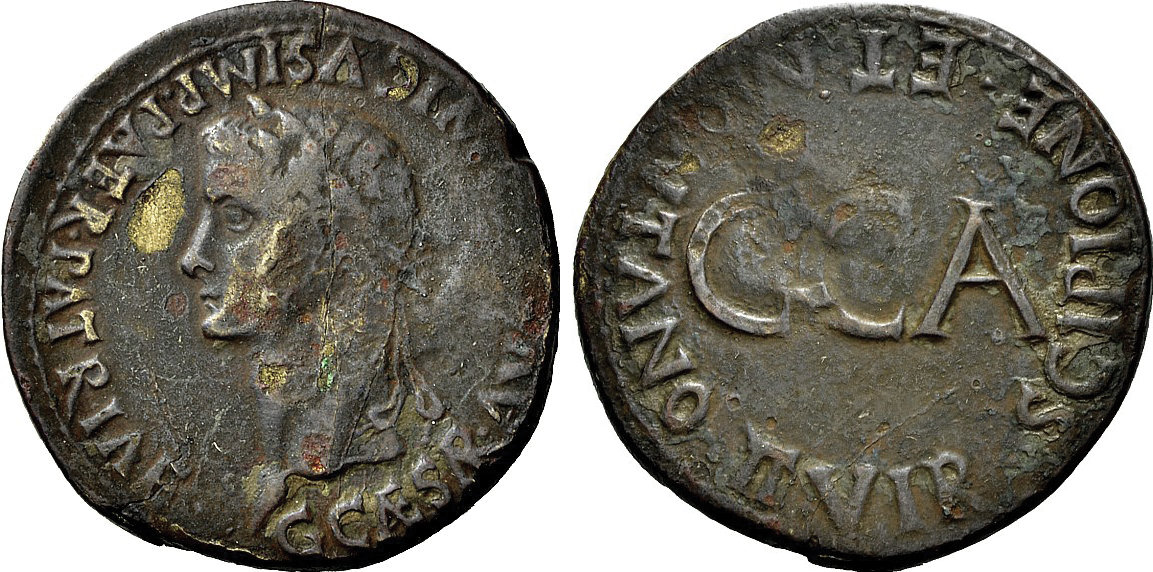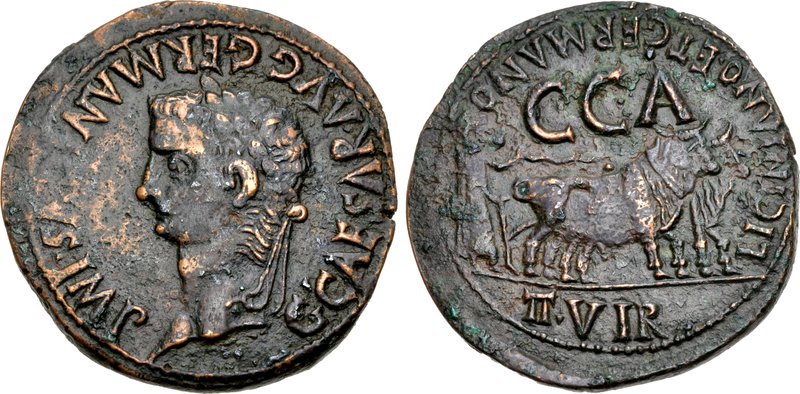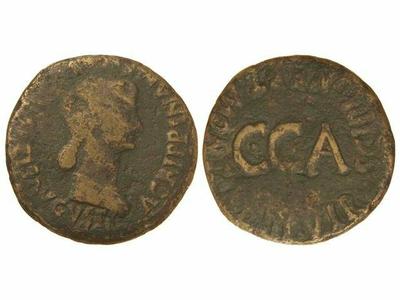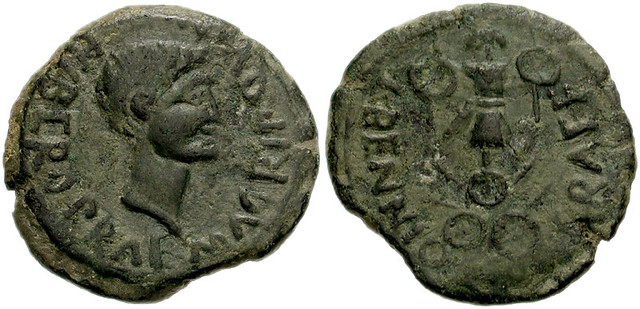What an interesting and complicated topic! I have had to ask myself a few questions? Do we
just accept that the Agrippan aes were struck under Gaius
Caligula because that is
just the way it is, on faith. Historically; and I think we underplay this in numismatics sometimes, what are the facts as we have them for a relationship with
Marcus Agrippa? Two questions here: Why would
Caligula want M.
Agrippa on an
obverse of a coin that was struck in bucket fulls according to the percentage extant/found in his short almost 4 year reign? Why would
Tiberius want to have M.
Agrippa on these coins for the years 14-37 A.D. which with percentage of coins extant for the
Rome issue alone makes more sense, but I am getting ahead of myself. I love collecting and all the coinage of
Caligula, and I would love to
just assume this was struck during his principate. I do have a problem or lack of understanding on one issue that is used for
Kraay 's number one reason for assigning the coin to
Caligula was the predominance of the
countermark TIAV for
Claudius, but
Jameson brings out an excellent point that M. Grant sheds light on in NC, 1948 page 116. (1) That this
countermark of TIAV is first found on coins of 29-30 A.D. , (2) The fact that the Spanish
Moneyers reproduce the
Agrippa type in company with types of Gaius. (3) The reference to Gaius as grandson of
Agrippa on coins of an uncertain mint of
Asia Minor? (RN, 1911, pg.432) The
Scipio and Montano moneyer 's could also be useful for dating. I think we can eliminate the countermarks for helping in securing a Tiberian date and that is
fine and the way it is. It would make no sense for
Tiberius to have a counterstamp of his own issue struck during his own principate? Anne
Robertson bring up the hypothesis for the 180 degree die-axis issue and her hypothesis seemingly convinced
Macdowall and Girard on "grounds of community both of
style and of countermarks". "
For discussion of this countermark on barbarous asses of Agrippa, see Kraay, "The Behavior of Early Imperial Countermarks" in Essays Mattingly, p. 127., and Giard, "Pouvoir central et Libertés locales" in RN 1970. The largest mass of evidence for the role of official aes 's has come down to us from the Julio Claudian period has come, so far, from the Rhine and Danube frontiers.
Initial theories and changes of the following views of L. Lafranchi-
Due to familial assimilation stylistic similarity between Agrippan
asses and the Imperial family of
Caligula, Lafranchi assigned these issues to the reign of
Caligula. He saw a familial dynastic connection. See reference below for first theory by Lafranchi.
See:
I Diversi stilli nella monetazione romana: gli assi ed I dupondi commeamortivi d Augusto e di Agrippa, RIN 1910, 21ff.
Lafranchi changes his mind almost 40 years later on the Agrippan
asses and thinks they were struck under
Claudius, not
Caligula.
See: La Monetazione Imperatorial e Senatoria di Claudio I Durante il quadrennio 41-44 RIN 1949, 41 ff.
Voetters Views and LaFranchi Response
Voetter thought that the Agrippan Gaius issues could be assigned to either principate due to the high volume number of hybrids available.
See:
Vienna Monatsblatter no. 24, 25 and 26. 1908
C.M Kraay- Views on Caligulan or Tiberian Strike
Kraay first believes that issues were struck under
Caligula, but due to Kuthmann 's observations on the Caesaraugusta imitations from Spain,
Kraay has changed his mind to a Tiberian strike date.
Original view by
Kraay: Because there were so many issues of this series of Agrippan
asses with the Claudian
countermark, TIAV. Not commonly found on coins before
Caligula 's principate.
SEE NOTE FROM 12/13 BELOW FOR MCDOWALLS VIEW ON TI AV MEANING?See: SMzB 1952, 53, and 56.
For Revised
Kraay View, see:
Die Munzfunde die Vindonissa 34f. M. Grant as
Jameson notes, NC 1948, 116. Grant states the first time an issue was found with the TIAV
countermark was in 29-30 A.D.
Due to the large number of bronze coinage that has survived Kuthmann has issues with the
Agrippa asses being struck under
Caligula for so brief of a principate.
See: SMzB 1054, 73ff.
See: For Spanish imitations, A.Vives, La Moneda Hispanica IV, 84, nos. 66-67.
The M.
Agrippa as series from Spain. Regarding Kuthmann 's observation on imitations of the
Agrippa aes
type from Caesaraugusta in Spain. It seems in earlier scholarship S.
Jameson,
Kraay and others who get into Portrait study on these imitations , this is dubious at best, and I usually always look at portrait types, square chin, or with terms like "square and sloping styles" as
Kraay mentions for Vindonissa issues. Which he puts into two groups, one for the
Rome mint and all others for provincial mints. I do admit that the
Rome mint
Agrippa aes are superior in
style and consistency, but sometimes this portrait study from provincial mints can be a bit far reaching? The Roman Imperial mint would have by far the best portraiture for numismatics and would have been exactly how the living princeps would have wanted that coin represented. On the
obverse and I agree with
Jameson that there are actually three portrait groups we should look at, Group A is of the best quality and consistency are from Rome-
A square set of the
head, and treatment of the eye, which is always marked HORIZONTALLY" giving a stern and determined appearance (may be too much read into this) to the
face. The hair is finely executed, especially the forelock, the tips of which curl slightly outwards, away from the forehead.
Group A- On Appearance
The
obverse of the
Agrippa aes issue represents a balanced uncluttered appearance, the relief is high; the
legend is drawn in large even letters, which are well spaced and give no impression of cramping the portrait. In comparison to the other 2 groups the "COS" will be seen to be larger and equally spaced. At this time , I only would like to concentrate on the
obverse portrait types of
Jameson and not the
reverse.
Group B- More on Jameson Observations
The
portraits of
Agrippa in group be often look similar to
portraits in group A, but; the execution of the features is very different. The eyes vary, sometime the brow is at an angle as though the eye was gazing upward, the hair is neatly executed but with less detail. Sometimes the eyebrow is curled, the forelock is either more ruffled or more often cropped of in a short fringe.
Group B- On Appearance
The
legend of the letters in "COS" often the "O" is smaller the the other two letters and tends to be spaced closer to the "S", leaving a gap between it and the "C".
Jameson as well as others believe this group belong to the Tiberian, Claudian or Neronian deviation.
Group C - Portrait observations Jameson
The coins of this group are quite distinct in
style, the
portraits have a great deal of variation. The main features are similar in that the
head slopes back and is more spread, the relief being less high , especially at the base of the neck, the hair is of a courser texture than those of Groups A and B. The forelock is short and almost always combed into a fringe which clings tightly to the forehead. The chin is prominent, often the depth of the chin to base of neck appears greater than that of forehead to crown.
Groups C- Appearance
The legends in this group are often not consistent, being cramped or has height differences.
Now, I did not include all of
Jameson 's pyhscological theories on the
Agrippa portrait which seemed to prevail pre- 1970 's. If you want to know more read:
Out of more than 100 coins Group A shows a Maximum
weight of 13.50 gm , this is on the high end , and is extremely heavy, although one-third weigh between 11.50 and 12.50 gm. And the
weight for any issue never drops below 10.25 gm.
Average weight is between 10.25 and 11.00. Group B and Group C are averaging the same but
weights decline respectively from groups A, B and C.
In the case of the Tiberian issue , it has been shown , on the evidence of the
die axis relationship and the types with which the
Agrippa portrait is combined to form hybrids , that probably originated in mid range of Tiberian rule. The
Agrippa as groups issued under
Tiberius was probably around 22-23 A.D. I wonder if this anything to do with the wonderful
dupondii and
sestertii that came out in the same year? Could this be when the die-axis changed? See: for the 22/3 A.D. series. https://www.forumancientcoins.com/NumisWiki/view.asp?key=The%20Domus%20Augusta%20Tiberian%20Dupondii%20and%20Sestertius%20Series-%20Joe%20Geranio
Jameson goes on, the
die axis under
Caligula is ÓÔ , BUT; this is also so in the reign of
Tiberius, with two exceptions (neither
asses). The
Agrippa coins always have the
reverse die-axis in a downward position.
Sutherland has demonstrated from an examination of the die-axis of the aes coinage throughout the reign of
Tiberius that while hh is dominant at the beginning and end of the reign , ¯ predominates during mid reign. In particular the providential
asses. Of the 29
asses of the
Agrippa type, both countermarked and non-countermarked, the
reverse die-axis is a follows: 10 specimens show ¯, 10 l, and 9 m. Therefore , if these issues are correctly attributed to
Tiberius, they are more likely to have been attributed to the middle
part of his reign. 22-23 A.D.
See: NC, 1941 100 and for Provedentia
asses 111.
Jameson Legends for Hybrids Evidence
IMP
CAESAR DIVI F AVGVS IMP XX
SC PROVIDENT
Group A - SC
The SC from group A of Jameson/Kraay 's (Die Munzefunde von vindonissa 35) chart shows the extremely large bold SC , the C is very round and almost a full
circle. On better specimens the C varies in thickness according to
Jameson.
If the SC is studied on the Tiberian aes is studied , they do not seem so rotund, more square than round. The letters themselves are thicker , the C is not fully fashioned on the Tiberian issue as on Group A
asses, but broadens into the serifs. As is sometimes the case with the "C" of Claudian
asses.
Jameson goes into great depth on these issues of legends and serifs and
flan distinction, see page 109-10 of NC , Vol. VI, 1966.
Regarding Countermarks
I have never been a big lover of countermarks/ counterstamps, but this is double complexity. Going through the nice site of Richard
Baker, "Museum of Countermarks on Roman Coins", here are the Tiberian coins that are on
Marcus Agrippa obverse coin
portraits.
"CAG" a "Hercules head", other countermarks for
tiberius could be , "B", TIB AVC, "TI.CA". CAESAR", and "Cornucopia". When you check the
Caligula section for countermarks we find for
Agrippa aes so called
Hofheim Type,
"TIAV", "TICA", "CAG" . Other countermarks for
Caligula are: "IMP", "TIBCLAIMP" "TI.C.A.", "TICA". Other
Caligula countermarks are: "CA", a"CAC", and "CAG". Out of more then 100 coins in group "A" of
Jameson 's article, there are no countermarks,
Jameson states this is not suprising due to the fact that they are of the finest
style and least worn pointing to minting at
Rome and remaining there. In Group "B" there are only small amounts of countermarked issues. In group "C" about 40% were countermarked.
Jameson states that almost all the unorthodox issues of the
Agrippa type are stamped with "
TIAV" and the variant "
TIN".
Here is
Jameson 's break-out on a chart
**
Jameson brings up the point that apart from the "DUBIOUS" C.A.C.
countermark, all the countermarks are Claudian. But, there is some controversy on the "TIAV" mark. If the
Agrippa aes were struck under
Caligula, then this makes strong evidence, and I believe "TIAV" is
Claudius for a few reasons, One; I believe it should be TIB or TI
CAES if it was
Tiberius, but of course;
Tiberius would not
countermark his own coins. After
Jameson 's chart, its clear it is Claudian and that makes sense even if the Agrippan aes were struck under
Tiberius. A friend and myself were discussing this and he had this thought, "
Well, in terms of purely scientific evidence, there 's no way that Caligula and Claudius coins would be countermarked (after lots of circulation) with the ligatured signature of a dead emperor. If the TI AV showed up on Nero coins, then it would have to be Titus; but it shows up on Claudius coins issued earlier in that reign, so it makes sense that it 's Claudius ' countermark. It 's true that there were beautiful coins issued in the middle of Tiberius ' reign, about the time Sejanus started becoming quite powerful. If they were found on both Caligula and Claudius coins in a certain area, then it means that a local authority used the ligatured signature of Ti (Claudius Caesar) Au(gustus) to mark coins of both Caligula and Claudius as still "probatus" (approved) for circulation. There is no reason to believe that these countermarks were applied to Caligula 's coins during his reign, because he did not rule long enough for the coins issued during his reign to get worn down enough to need stamping with a "PROBAVIT" type of countermark. My only question here is, why would a coin need a countermark so quickly after so short a reign of 37-41 A.D. for Caligula? You would think Neronian countermark or later? I do understand that Claudius ' reign was 13 years, so would a coin stuck under Caligula not last 13-17 years in circulation? ON TI AV- SEE NOTE FROM 12/13 BELOW FOR MCDOWALLS VIEW ON TI AV MEANING?
THE HISTORICAL EVIDENCE- UNDERATED?
How important is the historical evidence? Many have used the argument that Gaius Tranquillius Suetonius 23 is like reading the National Enquirer? Well lets look at the exact text in 23.
" He was unwilling to be thought or called the grandson of Agrippa, because of the obscurity of his birth; and he was offended if any one, either in prose or verse, ranked him amongst the Caesars. He said that his mother was the fruit of an incestuous commerce, maintained by Augustus with his daughter Julia. And not content with this vile reflection upon the memory of Augustus, he forbad his victories atActium, and on the coast of Sicily, to be celebrated, as usual; affirming that they had been most pernicious and fatal to the Roman people". (Caligula suetonius 23)
Well it says what is says. No matter how hard we may want to fit numismatics into the history of Caligula and his time, it is hard to ignore such a statement, and Sydenham in NC, (1963) 262 has argued for Tiberius having a much tighter rapport with Agrippa through marriage with Vipsania and the writing of C. Velleius Paterculus in which he wrote:
" It is but rarely that men of eminence have failed to employ great men to aid them in directing their fortune, as the two Scipios employed the two Laelii, whom in all things they treated as equal to themselves, or as the deified Augustus employed Marcus Agrippa, and after him Statilius Taurus. In the case of these men their lack of lineage was no obstacle to their elevation to successive consulships, triumphs, and numerous priesthoods. For great tasks require great helpers," (Velleius 2.127)
Mattingly has said in a conversation with C. Rodewald that, (The Money Of Tiberius 1978) " that he still regards these historical considerations has weightier than the numismatic arguments against inception under Tiberius. "He believes that the bulk, at least, of this issue was produced between 22-31 A.D."
12/13
According to D.W. Macdowall and Hubrecht on page 266 of , " Countermarks on the Ae 's of Claudius from Nijmegan". " TI AV should stand for TI(berius) AV(gustus) , the Roman emperor 14-37 A.D., who succeeded Augustus. In this form the countermark only occurs on sestertii of Claudius. A second form of TI AV occurs extensively at Vindonissa and sites in upper Germany on sestertii of Caligula and Claudius; and a third part of the countermark is found widely on copper asses- at Hofheim on 48 out of 61 (78%) of both orthodox and irregular asses of agrippa. Kray suggested that TI AV may have served the purpose of restoring the obliterated name of Claudius; but the obvious interpretation of TI AV is an abbreviation standing for Tiberius, not Claudius; and the legend TI CAESAR DIVI F AVGVSTUS was the regular form of titulature employed on the ae 's of Tiberius. We therefore suggest that the coins countermarked TI AV were being given the status of sestertii and dupondii of Tiberius struck at the mint of Rome."
As simple as it sounds, Gaius Caligula 's reign was just too short for such a vast amount of issues for the Agrippa pieces. If you accept the TI AV as Claudius as princeps this also strengthens the coin as struck under Tiberius. Update 12/12. More to come.
A. Barrett in , Caligula: The Corruption of Power ( Great book by the way) pg. 251.
The commonest of the issues of Caligula is the common "so called" Agrippa as. (BMC) Tiberius 161, fig. 24. It depicts on its obverse a bust of Agrippa, facing left, with a rostral crown and the legend M AGRIPPA L F COS III. On the reverse is a Neptune holding a dolphin in his right hand and a trident in his left, and the letters SC. It is found most commonly on the Rhine frontier. Scholars have generally accepted that this coin was minted under Caligula, but it has been argued by some that it first appeared under Tiberius. Opinion has differed over whether it has been produced at a number of different mints, in the provinces as well as Rome. J. Nichols, however has pointed out, that the adjusted die axis of these asses, with 'upside down ' , is not compatible with that of Tiberian coins. In the mid- Tiberian coins the adjusted die axis with upright reverse is always is always found on at least some of his aes. By the end of his reign it predominates. There are no Agrippa asses found with this arrangement, which is also foreign to Caligulan issues. Nichols argues that Caligula issued this coin in conjunction with other family types, to be continued under Claudius although in reduced numbers. She suggests that the coins originate in the issues of the colony of Nimes, (Nemausus) bearing the portraits of Agrippa and Augustus, back to back, which were often neatly halved to keep the heads intact. The Agrippa as represent the continuity of this tradition. The Agrippa as was imitated in issues of Caesaraugusta, the richest of the local mints of Spain. As shown by the names of the moneyers the colony produced three coin issues, dated by Trillmich to the first three years of Caligula 's reign. The Agrippa imitations appear in the second and third issues".
Here are examples of the halved issues which were easy to break down by portrait mentioned by Barrett.
THE MONEYERS SCIPIO AND MONTANUS AND TITTULO AND MONTANUS- Licinianus and Germanus, duoviri.
DATING OF THE CAESARAUGUSTA ISSUES IS CRITICAL
The moneyers spoken about by Barrett are (The Moneyers of Scipione and Montanus and Titullus and Montanus) These are from the richest mint area 's for Spain. Here are the two issues.
FIRST IS SCIPIO AND MONTANO DVOVIRI:
SPAIN, Terraconensis. Caesaraugusta. Agrippa. Died AD 12. Æ 29mm (13.40 g). Scipio and Montanus, duoviri. Struck under Gaius Caligula, AD 37-41. Head left, wearing rostral crown / Priest plowing with yoked oxen right. RPC I 381.
SECOND IS TITULLUS AND MONTANO DVOVIRI:
CAESARAUGUSTA. Spain. Sestetius. Calígula (37-41 d.C.). Head of Calígula laureate Left. G CAESAR AVG GERMANICVS IMP PATER PATRIAE. Inscription- C C A. SCIPIONE ET MONTANO II VIR. AE 23,05 g. I-385. V- 154.1. RPC- 373.
SPAIN, Caesaraugusta. Gaius (Caligula). AD 37-41. Æ As (30mm, 11.52 g, 6h). Licinianus and Germanus, duoviri. Laureate head left / Founder plowing right with yoke of oxen. ACIP 3100a; RPC I 371 (Joe Geranio Collection)
COINS FROM SPAIN AREA WITH PORTRAITS OF AGRIPPA/ STRUCK UNDER AUGUSTUS- (this is to show familial assimilation from AVG-Tiberius and Gaius
Caligula)
Joe Geranio
http://groups.yahoo.com/group/julioclaudian/

